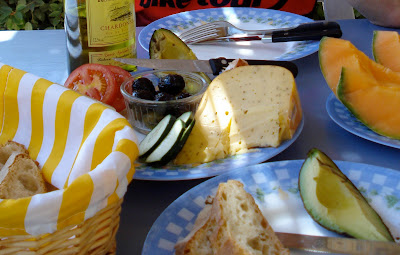I had two wake up calls this past week, regarding the calorie content of foods.
 |
| Macarons stacked at La Duree, Paris.Typically French portions! |
First, I walked into a local Starbucks and saw a new, and quite adorable, display of mini pastries. Maximum two-bites-sized, these charming micro cupcakes and nano whoopie pies had proudly displayed tags which announced their value, "190 calories".
And how did I feel? Well, quite mixed, to be honest. It was truly a reality check seeing the caloric value of such tiny pastries. It was nice to see that in a small portion, delicious baked goods could fit as a snack for most anyone, calorie-wise. But how satisfied would I feel with something gone in only two bites, I wondered.
For some of you, it may feel good satisfying your taste from a controlled portion. For others, it might require a box of these cute, but oh-so-small delights. Do you label foods 'good' versus 'bad', 'allowed' versus 'forbidden'? Starbuck's strategy of displaying calories may actually help you, helping you to see that in a small portion, even calorie-rich items can fit in your diet.
| Even without the calories listed, can't you see these are small enough to include? |
The second shock
I invited a teen patient of mine to bring in menus from the many restaurants he dines in weekly. Now here's the thing. Nutrition is my field, and I'm not naïve (you've noticed?). And yet when I examined the dinner entrees I was aghast. Single meals, for one person, with calorie counts around 2000! Saturated fat covering 3-4 days' allowance for health, sodium content in the 2000-3000 mg range, exceeding the recommended daily range for even healthy Americans (2,300mg/day, and 1500 mgs/day for those with high blood pressure). And that was just from a single meal.
Yes, even I was shocked. And also surprised by my own response; I was pleased to have that information available! And, to be able to share it with my patient, to enable him to be able to make a well-informed, healthier choice, from the entrees that appealed to him. Or, to be more mindful of his portions of such meals, if he chose to order one.
"But I thought you were against counting calories?"
I am. I am not in favor of adding up calories throughout the day, with a goal of limiting the total to a specific number. And, in doing so, likely deny your physical sensations such as hunger. Imagine you try to keep your intake to some (somewhat arbitrary) level. And by 5 PM you've reached your total. Yet your stomach is growling and you know that your body needs the fuel, the calories. Then what? See the problem? This calorie-counting method for weight control is not a perfect science. Even individuals of the same height will have differing needs. Those formulas that seem to calculate your daily requirement so scientifically are merely estimates, a ballpark figure, nothing more.
As for the calories on menus, here's another true patient story that helped shift my opinion.
I kid you not!
Jamie was a patient I worked with awhile back. She was overweight (without any eating disorder or disordered eating), and wanted to lose weight. Working as a manager at a non fast food restaurant chain, she had the luxury of ordering whatever she pleased from the menu (free, I might add). She just needed some guidance selecting wisely.
She showed me the menu, and unfortunately, there were few items that jumped out as healthy, to support her goal of weight loss. But the pasta primavera caught my eye, filled with veggies, not in a cheese sauce or alfredo. So I started there. As I recall it, this dish was described as containing a light sauce, made with wine. "Can't we just modify their portion of this dish?" I asked.
Not a chance, she smirked. "You know what goes into that dish?" she replied. An entire stick of butter, per plate! Yes, eight tablespoons. In my dreams (nightmares?) I would never have imagined it. Perhaps this sauce was light in color, but it's description failed to inform me of the richness of this meal.
Now if I had seen the menu with the nutrition info, it would have given me a heads up.
 |
| From L'Etoile, tops in Madison, Wisconsin! No camera with me last night at Hamersley's Bistro! |
So I'm a bit conflicted. I like having nutrition information available, but I feel it should be our choice whether we want to view it or not. Perhaps we could ask for the labeled menu, if we so choose. Just a thought. What do you think would be most helpful for your goals?
Last night, enjoying a celebratory meal dining in a lovely restaurant in Boston, the last thing I would've wanted to see next to the the pear galette (think buttery pastry) with ginger ice cream and a caramel sauce is the calorie value. Yes, my caloric intake for the day was certain to have exceeded the estimate by any equation. And so it was. I enjoyed every bit of my meal. And I don't eat like this daily. I shared this delectable dessert, and interestingly, was just comfortably full after my meal.
Ultimately, you may find it helpful to observe the calorie info on menus and on labels. It may help you choose between products, to help you meet your goal for weight regulation, particularly when you are just starting out. You may not trust your body just yet. But if you also focus on mindful eating (as described throughout this blog), and start to separate your physical hunger from all the other reasons you eat, you'll do much better.
If you choose to use it, consider the calorie content as just one aspect of your eating. Choose what you enjoy, and try to use your body, and its fullness, as a guide.














